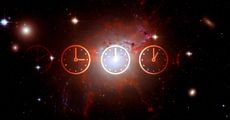The great solar eclipse of 2017
On Aug. 21, the moon's shadow will roll across the U.S. as tens of millions of Americans witness a total solar eclipse

On Aug. 21, the moon's shadow will roll across the U.S. as tens of millions of Americans witness a total solar eclipse. Here's everything you need to know:
Why do total eclipses occur?
Occasionally, the moon's elliptical orbit carries it directly between the sun and Earth, placing all three celestial objects in complete alignment. The moon's shadow then falls across Earth's surface, ultimately appearing to blot out the sun entirely. The phenomenon isn't especially rare, occurring somewhere on Earth every 18 months or so. But from any single given spot, a total solar eclipse is observable only once in 375 years. This one will be the first anywhere in the U.S. since 1979, and the first since 1918 to be visible from coast to coast. It will also be the first solar eclipse to be seen only on American soil since 1776. "The path of totality will cross through a whopping 14 states," says astrophysicist Ethan Siegel. "More than 12 million people will get to experience totality without ever leaving their homes."
Subscribe to The Week
Escape your echo chamber. Get the facts behind the news, plus analysis from multiple perspectives.

Sign up for The Week's Free Newsletters
From our morning news briefing to a weekly Good News Newsletter, get the best of The Week delivered directly to your inbox.
From our morning news briefing to a weekly Good News Newsletter, get the best of The Week delivered directly to your inbox.
What will eclipse gazers see?
It's a gradual process, beginning with first contact — "when the sun and moon 'touch,'" explains NASA heliophysicist Mitzi Adams. "This leads to the partial phase, when it looks like someone is taking increasingly large bites from the sun. Next is the actual eclipse itself, when the sun is totally covered by the moon." All that is visible then is the solar corona, the sun's gaseous halo, which peeks out from the blackness. Totality lasts from a few seconds to just over two minutes, depending on where you view it. The sun's brightness in the totality falls by a factor of 1 million, temperatures plummet by as much as 20 degrees, and winds fall still. "Some animals react," Adams says. "Cows may start walking toward the barn. Crickets start chirping." Indeed, the sheer strangeness of eclipses has inspired fascination — and fear — since ancient times.
How so?
For centuries, people saw eclipses as omens, perhaps as harbingers of Doomsday. "When anything extraordinary happens in nature it stimulates a discussion about instability in the universe," says astronomer Anthony Aveni. In Indian mythology, it was believed eclipses occur because the Hindu demon Rahu continually chased the sun and occasionally swallowed it up. The Babylonians, one of the first civilizations to study the cosmos, believed eclipses heralded the death of their king; by the 8th century B.C. they had devised mathematical formulas that predicted them. (To "fool" an impending eclipse, they'd dress someone up — usually a condemned man — as a substitute monarch.) Greek historian Herodotus credits the philosopher Thales with accurately predicting the solar eclipse of May 28, 585 B.C. "People realized there were patterns," says astronomer Tyler Nordgren. "If it is a dragon eating the sun, then evidently the dragon works on a timetable."
What's the timing of this eclipse?
Beginning at 10:16 a.m. in Government Point, Oregon, the eclipse will follow a 67-mile-wide path from Oregon through Idaho, Wyoming, Nebraska, Kansas, Iowa, Missouri, Illinois, Kentucky, Indiana, Tennessee, North Carolina, Georgia, and South Carolina — ending near Charleston at 2:48 p.m. Some 75 million people live within a 200-mile drive of the totality path, and large crowds are expected to gather in towns and cities along the route, snarling traffic and straining infrastructure and emergency responders. To prepare, communities are coordinating with government, law enforcement, and food vendors, and ferrying in portable cellphone towers. Glendo, Wyoming — population 200 — set up an airstrip viewing area to accommodate some 20,000 visitors. Eclipse watchers are advised to bring their own food and water and take appropriate safety precautions (see below). "The biggest shortage on the day will probably be port-a-potties," predicts geographer Michael Zeiler.
Will scientists learn anything from the eclipse?
They usually do. For example, reduced glare during the total eclipse of 1919 enabled British astronomers Arthur Eddington and Frank Watson Dyson to observe the extent to which solar gravity bends starlight — confirming a key prediction of Einstein's general theory of relativity. This year, in a project dubbed EclipseMob, astronomers across the country will use special radio receivers to study the ionosphere, an atmospheric region between 46 and 621 miles above Earth ionized by solar and cosmic radiation. Day-to-night ionospheric fluctuations can disrupt radio waves and communications systems. (Ion reduction after sundown is one reason AM stations come through better at night.)
Are there other projects?
In Citizen CATE (Continental-America Telescope Eclipse), astronomers from coast to coast plan to splice film footage into the longest-ever movie of a total solar eclipse — about 90 minutes' running time. Their primary goal is to analyze the solar corona. Normally almost invisible, the corona is revealed in striking detail during an eclipse. It's a turbulent region, with temperatures up to 3.5 million degrees Fahrenheit, swirling solar winds, and coronal mass ejections — scorching ionized particles that fly toward Earth, pummeling our atmosphere and sparking the aurora borealis. These ejections pose threats to astronauts, satellites, and ground-based technology, and generate powerful currents that can short out power stations, potentially imperiling the grid. CATE researchers have meticulously synchronized their specialized cameras; there's no chance for retakes until the next total eclipse in the U.S. in 2024. "You have to be ready when totality starts," says astronomer Matt Penn, "because you can't stop the moon."
How to view the eclipse
It's not an old wives' tale: You can permanently damage your eyesight, or even go blind, by staring at an eclipse. "The only safe way to view the eclipse directly is through sufficient eye shielding," warns astrophysicist Ethan Siegel. That would include specialized glasses, designed explicitly for solar viewing; gazing through welder's glass/goggles/hoods, "where you need shade 14 or higher glass to be safe"; or through a telescope or binoculars only if they're fitted with a specialized solar filter over the outer lens. "Only during absolute totality is it safe to remove your glasses," Siegel says. During that all-too-brief period — if skies are clear — you can check out the sun's corona and Regulus, an extremely bright star next to the sun. Siegel says that if viewing conditions are perfect, you might also see "the planets Mars and Mercury, ahead and behind the path of the sun, respectively."
Sign up for Today's Best Articles in your inbox
A free daily email with the biggest news stories of the day – and the best features from TheWeek.com
-
 Today's political cartoons - February 22, 2025
Today's political cartoons - February 22, 2025Cartoons Saturday's cartoons - bricking it, I can buy myself flowers, and more
By The Week US Published
-
 5 exclusive cartoons about Trump and Putin negotiating peace
5 exclusive cartoons about Trump and Putin negotiating peaceCartoons Artists take on alternative timelines, missing participants, and more
By The Week US Published
-
 The AI arms race
The AI arms raceTalking Point The fixation on AI-powered economic growth risks drowning out concerns around the technology which have yet to be resolved
By The Week UK Published
-
 Are zoos ethical?
Are zoos ethical?The Explainer Examining the pros and cons of supporting these controversial institutions
By Justin Klawans Published
-
 Will COVID-19 wind up saving lives?
Will COVID-19 wind up saving lives?The Explainer By spurring vaccine development, the pandemic is one crisis that hasn’t gone to waste
By Noah Millman Last updated
-
 Coronavirus vaccine guide: Everything you need to know so far
Coronavirus vaccine guide: Everything you need to know so farThe Explainer Effectiveness, doses, variants, and methods — explained
By Jeva Lange Last updated
-
 The climate refugees are here. They're Americans.
The climate refugees are here. They're Americans.The Explainer Wildfires are forcing people from their homes in droves. Where will they go now?
By Joel Mathis Published
-
 Coronavirus' looming psychological crisis
Coronavirus' looming psychological crisisThe Explainer On the coming epidemic of despair
By David Faris Published
-
 The growing crisis in cosmology
The growing crisis in cosmologyThe Explainer Unexplained discrepancies are appearing in measurements of how rapidly the universe is expanding
By Matthew Francis Last updated
-
 What if the car of the future isn't a car at all?
What if the car of the future isn't a car at all?The Explainer The many problems with GM's Cruise autonomous vehicle announcement
By Navneet Alang Published
-
 The threat of killer asteroids
The threat of killer asteroidsThe Explainer Everything you need to know about asteroids hitting Earth and wiping out humanity
By The Week Staff Published